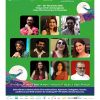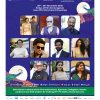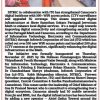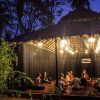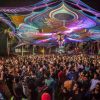Goa is abuzz with excitement as vintage bike and car owners, users, collectors and fans are decking […]
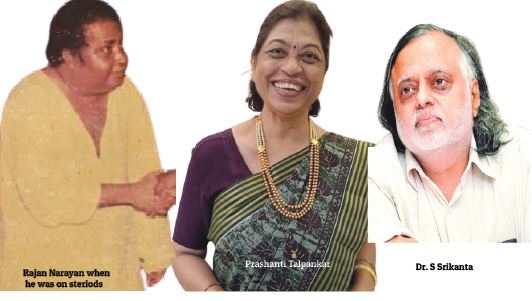
MEMOIRS OF AN UNDERDOG JOURNALIST! `I have no sacred cows!’ `I’m the goonda with the pen!” NARVEKAR MOLESTS, I GET BEATEN UP!
July 20- July 26 2024, Life & Living July 19, 2024By Rajan Narayan
IT was first week of September 1989. I got a call from my contacts that in the Goa Secretariat the 19-year-old pretty young woman Sunita Haldankar was suffering molestation from the then Speaker of the Legislative Assembly Dayanand Narvekar. The victim was a contract employee in the office of the speaker. The story goes that Dayanand Narvekar called her into his chamber at the Adil Shah Palace (old Secretariat). Allegedly he asked her to strip and he started taking off his own clothes. He told Sunita Haldankar that she would lose her job is she did not oblige him. Sunita raised an alarm, rushing out of the cabin of the speaker in tears. The staff of the speaker rushed to console her.
Subsequently, the mother of the victim went to the press room on the ground floor at the Adil Shah palace and informed media persons in the press room of what had happened. Everyone was willing to believe Sunita because Dayanand Narvaker’s reputation with women preceded him. Narvekar also owned a small bar and restaurant on the ground floor of Junta House, near the Fidalgo Hotel, called “Hot Lips.”
On the mezzanine floor of “Hot Lips” he had a love nest for himself. I also recall the manager of the Tiracol Resort once confiding in me that he could not give a suite at the resort to me for it was permanently booked for Dayanand Narvekar. The molestation issue was taken up by the then Leader of the Opposition Ramakant Khalap. The young Khalap got very emotional over the issue. He also saw it as an opportunity to launch an attack on the Congress party led by Pratapsingh Raoji Rane.
The victim Sunita was introduced to the media at the residence of Baba Naik, a senior MGP leader, at his ancestral house in Mala in Panaji. Victoria Fernandes was present to express solidarity with the victim. The victim gave a graphic account of what had happened to her in the Speaker’s Chamber. Ramakant Khalap demanded the dismissal of the speaker Dayanand Narvekar. Narvekar refused all demands for his resignation from the post of Speaker of the Legislative Assembly. On the contrary, he claimed that the victim and her mother did not have a good reputation. That the victim had made false allegations against him. Nobody of course believed Dayanand Narvekar.
As editor of OHeraldo then I took up the issue. I wrote a series of front-page editorials demanding the resignation of Dayanand Narvekar. I appealed to the then members of the Legislative Assembly to move a vote of no confidence against the speaker, Dayanand Narvekar. Chief Minister Pratapsingh Raoji Rane did not take any action against Dayanand Narvekar. The Congress party also kept silent on the charges against Narvekar. I kept filing reports and editorials exposing the playboy image of Dayanand Narvekar. The irony is that Narvekar’s very pretty wife was not willing to defend him.
It became a people’s movement with no signs of Narvakar voluntarily quitting his post and the young Prashanti Talpankar decided to go on an indefinite hunger strike at the Azad Maidan from September 11, 1989. Prashanti was then a member of the Progressive Students Union and an outspoken voice for women’s causes. She gave the government notice to take some action within ten days or she would go on her hunger strike.
Prashanti started her hunger strike on September 11 along with 70-year-old freedom fighter Vinayak Padiyar and 18-year-old Vasanti Panchal. At midnight the police came to pick up Padiyar saying his hunger strike was suicide and he was breaking the law. From the OHeraldo office I had gone out to see them after putting the paper to sleep and when I reached the venue. My friends Ashwin Tombat and Sandesh Prabhudesai were there with the hunger strike team along with a few RSS people. We had to make a chain around the place to stop the police form dragging Padiyar away.
There was a Ganesh Chuturthi procession in the vicinity and the crowd from there came help us stop the police; September 14 there was a huge student’s morcha and the next day on the 15th a worker’s morcha. It was perhaps too much and on September 16 Dayanand Narvekar resigned. Prashanti broke her fast that evening and later on went on to become a well-known actress in Konkani cinema. Also a writer with a Sahitya Kala Academy Award for translation in her cap.
But to return to my story it was Saturday, September 16, 1989 when Dayanand Narvekar resigned as speaker of the Legislative Assembly. The day before he resigned I had taken a ride around his bungalow in Altinho with Fr Oscar Quadros. There I was almost attacked by supporters of Dayanand Narvekar. I should have sensed the anger of the vindictive Dayanand Narvekar.
On Friday, September 16, 1989 late night I was returning from my office at Fontainas area at around 10 pm. One of the “OHeraldo” directors, John Fernandes, dropped me at the Dona Paula circle just where the lane where I lived started while he continued further down to the Dona Paula jetty. From the Dona Paula circle my basement flat at Mendes Haven was just 100 meters away on the route to Hawaii beach further down. Mendes Haven is located just behind the Dona Paula police outpost. All the streetlights around the Dona Paula circle had been switched off.
I subsequently learnt that the transformer had been tampered with. I had barely walked 20 meters in the gloomy darkness where the lane began when the group of goons caught me and started hitting me at the back of my neck, where my spine begins. They had iron rods and cycle chains and as they used them mercilessly I spontaneously kept ducking my head and perhaps this is what saved my life that night. If they had hit me directly on the head I doubt if I would have be alive today to write any memoirs.
It was my spine which took the brunt of the savage attack on me. I started shouting and it attracted the attention of the residents of the building called La Pastina, next to Mendes Haven. The owner of the building was Pascoal Fernandes, he put on his balcony light and came rushing down. With the lights coming on the goons stopped hammering me and ran. Their car was parked next to the Dona Paulo police outpost nearby, they got into the car and fled.
I collapsed on the road with blood flowing out of me. My back was bloody with the deep marks of the iron rods raining down on me. I was lifted and carried to the flat of Pascoal Fernandes, I believe it was Pascoal who called the police. An ambulance arrived and unconscious I was taken to the Casualty at Goa Medical College & Hospital where my wounds were treated.
I understand that the CT scan done mercifully revealed no head injuries. But my spine was severely bashed up and I was in considerable unbearable pain. Prashanti Talpankar (who later married Sandesh Prabhudesai) who had broken her fast earlier in the day with the resignation of Dayanand Narvekar had also been admitted to the GMC for a checkup as her blood pressure had come down. After she was discharged she came to meet me with Sandesh and the spacious private room in the old GMC building in Panaji which is now the Entertainment Society of Goa (ESG).
Chief Minister Pratapsingh Raoji Rane and virtually the entire cabinet came to visit me in the hospital. Among the first to arrive was MGP leader Ramakant Khalap. All my doctor friends also came to visit me. After a week or so I was discharged and allowed to go home. From the day I was admitted to the GMC the Goa police stepped up my security. Besides assigning personal security officers there was a whole battalion of Goa reserve police armed with guns. But the guns they carried were world war rejects. By the time they lifted and got the gun in action anybody could have shot them first. They accompanied me to my basement flat and kept me company. The Goa Reserve Police camped in the staircase to my basement flat. The PSOs guarded the door.
It was all very funny. I did not get any protection when I had informed the police earlier about receiving threats from speaker Dayanand Narvekar’s supporters. Only after I was nearly killed I was given security. The news of the assault on me made national headlines. My family in Mumbai was very worried. My elder brother N Vaidhyanathan and my sister Lalita Dhara rushed to Goa from Mumbai.
After ten days the real effect of the beating up began to surface. I had acute pain all over my body, particularly in my back, hands and legs. I was re-admitted to the GMC where Dr NGK Sharma was the HOD of Medicine. In his anxiety to treat me Sharma started me on deadly steroid doses. Steroids are a wonder drug to relieve pain but they leave behind very severe long-term side-effects as I was to discover later.
As I continue to suffer from unbearable pain, Dr Sharma increased steroid dosage progressively and it went up to over 100 milligrams of “Wysolone.” The side effects of steroids like diarrhea, vomiting and nausea started manifesting and my body started water retention. It swelled up like a balloon. My top half also swelled up including my face. This symptom is called “moon face.” I found myself getting worse than when I was admitted at the GMC in the beginning.
A month after I was admitted to the GMC in Panaji the then chief minister, Dr Proto Barbosa and Dr Wilfred D’Souza visited me. Dr Wilfred D’souza was shocked by my condition and being an excellent surgeon himself he suggested that I should shift to Mumbai “otherwise the GMC will kill you.” Industrialist Dattaraj Salgaocar who was also present while Dr Barbosa and Dr Willy were visiting me, said he had a brother-in-law, neurologist Dr Madhav H Kamat, at the Jaslok hospital in Bombay. Dr Ness Wadia, the famous neurologist, also consulted at Jaslok hospital.
It was Dattaraj who arranged for me to travel to the Jaslok hospital in Bombay. Dr Sharma panicked and abruptly withdrew the steroids I was drugged with. Normally, steroids must be tapered off a patient very gently. However, the abrupt withdrawal of the steroid medicines resulted in me going off into what is called a steroid coma and consequently I was transported on a stretcher on the aircraft on which I was booked. About six seats in the aircraft were removed to make place for my stretcher which had to be bolted to the floor of the aircraft.
To make matters worse I was on the drip throughout the one-hour flight to Mumbai. My friend Fr Oscar Quadros accompanied me to Mumbai in 1989 and I was received at the Mumbai airport by a very old friend of mine, CS Mirchandani. “Mirchi” as friends called him, and I met when we were both staying in paying guest accommodation in Dadar way back in 1970. Anyway, Mirchi accompanied me to the 20-storeyed Jaslok hospital on Pedder road in south Mumbai.
At the hospital they restored me to consciousness. A wide range of tests were conducted including a spinal lumber puncture to withdraw spinal fluid for examination of spinal damage during my beating up. I recall that a junior resident poked me in the spine with a big needle repeatedly and then said there was no fluid in my spine.
Finally, a senior anesthetist pushed him aside and did fine needle aspiration test himself. An elaborate nerve conduction study was also done by a very dedicated Parsi doctor. Unfortunately, Dr NGK Sharma earlier at the GMC in Goa had totally confused my case. In my discharge certificate he perhaps mischievously suggested that I could either have polymyositis or peripheral neuritis. Polymyositis requires large doses of steroids as it is a muscle wasting disease. Neuritis only affects the nerves and steroids are not needed.
By the time I got to Jaslok my symptoms were masked. So Dr Wadia too could not arrive at any conclusive confirmation of diagnosis. If it was polymyositis they could not withdraw steroids. The more senior and reputed a doctor is the less he is willing to take a risk. Particularly, if the patient is a journalist. I was discharged from Jaslok hospital after three months with the advice that I should gradually cut down on steroids.
Whenever I brought it down to 60 mg my acute pain started all over again. I went to Dr BS Singhal at Mumbai hospital for a second opinion. With the same result, Dr Singhal too did not want to risk taking me off steroids. So it continued as I went from hospital to hospital looking for relief for my pain if not a cure. I went to Christian Medical College & Hospital in Vellore. I went to the All-India Institute of Medical Sciences in Delhi.
I even went to the National Hospital at Queen’s Square in London. All that they did was put me on various “downers.” Steroids are “uppers.” So I lived between wild mood swings between these two drugs. I returned to Goa when my weight had gone up to 180 kg, I looked like a Sumo wrestler. With cataracts in both eyes my vision deteriorated considerably and I had to use huge magnifying glasses to read. My misery continued for five years. I had gone to the Sankara Netralaya in Madurai in Tamil Nadu, the country’s best eye hospital. They refused to operate on my eyes because they did not know how I would react to anesthesia.
I left to return to Goa. At Bengaluru airport I fell and suffered multiple fractures. A friend at the airport recognized me and took me to the Mallya hospital. Here a young endocrinologist who had just returned from the US, Dr Sathyanarayana Srikanta decided to take a look at me. Dr Srikanta told me that I was a typical case of a disease caused by over dosage of steroids.
Dr Srikanta actually begged me to detox from steroids. I told him that the best neurologist had warned me that I would die within a week if I discontinued with steroids. Dr Srikanta said I would die within a month if I continued my steroid medication. I told him I would think about it and returned to Goa.
I came back to Goa end-June and consulted several doctor friends in Mumbai, particularly Dr SN Amin who was a rheumatologist at a Mumbai hospital. Various doctors advised me to go for the steroids detoxification. I threw a grand birthday party at my basement flat on July 4, 1994. Among those present was the late Daya Shankar, director of Customs in Goa, and the IB chief, Mr Chandrashekar. Also present were Justice Ferdin Rebello and Justice Daga of the Bombay High Court.
I informed everybody about my decision to do the steroid detox at Mallya hospital in Bangalore which would take six months. I didn’t expect to return. I gave away all my books, my rocking chairs and my large collection of over 250 precious Ganesh idols. Needless to say none of them returned to me when I returned after my stay in the Bangalore hospital to a new lease of some kind of a life anew!
In Bangalore or Bengaluru I put myself trustingly into the hands of Dr Srikanta and the success story of my detoxification from steroids over a period of five months is another chapter in my memoirs of a journalist who lived honestly if not wisely and profitably.
(to be continued)










